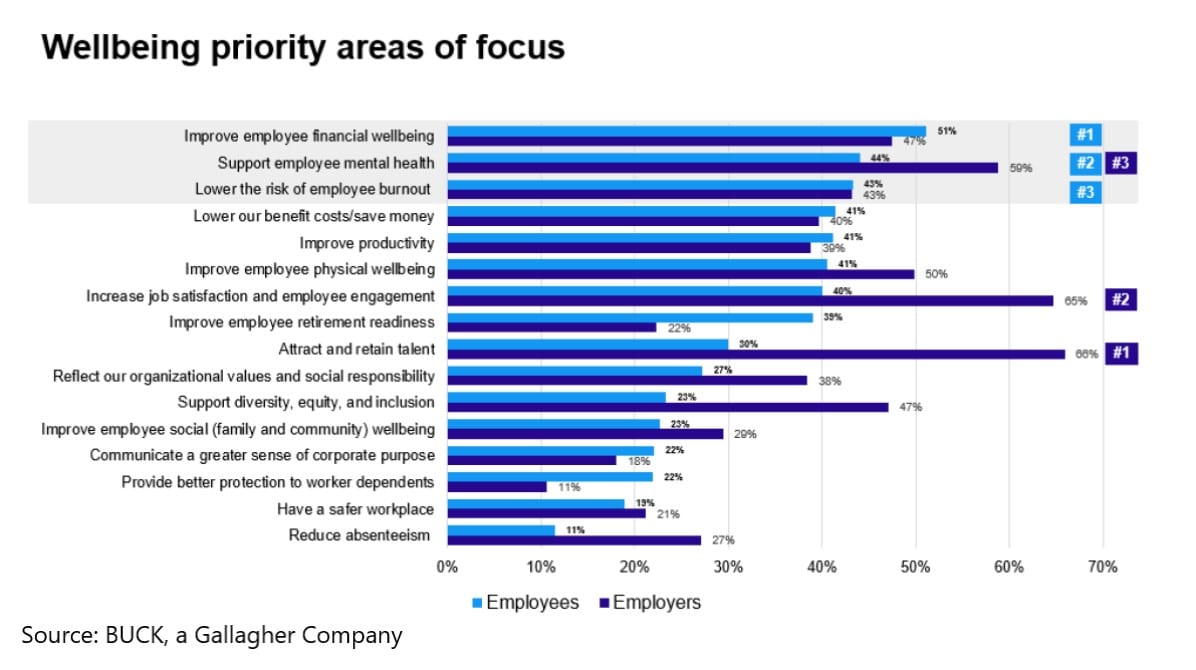[ad_1]
Regardless that worker wellbeing has more and more come into the highlight lately, many workers nonetheless really feel their employers aren’t investing in the advantages that would actually assist their wellbeing, based on a brand new report from human useful resource consulting agency Buck.
In Buck’s 2024 Wellbeing and Voluntary Advantages Survey—which queried 255 massive U.S. employers and 698 workers—when requested about their priorities for worker wellbeing, there have been some stark contrasts between employer and worker views. Leaders, as an illustration, cited attracting and retaining prime expertise and driving worker engagement as their prime technique of strengthening worker wellbeing. In the meantime, employees themselves seem extra centered on their day-to-day wants, similar to monetary wellness and psychological well being.
In a good labor market, that disconnect in worker wellbeing is one thing HR must be keenly conscious of—particularly on condition that 63% of workers would change jobs for higher advantages, based on Buck’s report.
One concern that could possibly be driving the divide on worker wellbeing, consultants say, is inadequate advantages communication: Seventy-four % of employers word they intend to extend their dedication to worker wellbeing within the subsequent one to a few years, however solely 50% of workers say they’ve seen such a rise thus far. Presently, 55% of workers say they don’t perceive their advantages, provides Tom Kelly, a principal within the well being apply at Buck.
Kelly notes that—along with aligning advantages choices with worker wants—clear and thorough communication about out there advantages is essential to serving to employees really feel their wellbeing priorities are being addressed.

The right way to shut the divide on worker wellbeing priorities
Though analysis has discovered sturdy ties between optimistic worker wellbeing and improved worker engagement and attrition, a latest report from worker engagement platform supplier Reward Gateway discovered that simply 40% of workers suppose their firms are doing a superb job supporting worker wellbeing.
Kelly presents a number of advantages areas the place HR can focus to assist their employer meet workers’ wellbeing priorities.
Monetary wellbeing
Workers’ No. 1 wellbeing focus is enhancing their monetary well being, cited by 51% of workers as a precedence. However for employers, it ranks No. 4.

The survey discovered that 92% of workers need further monetary sources from their employer, up from 79% in 2022. Moreover, 58% of employees dwell paycheck-to-paycheck, and one in three say they can’t afford a $500 sudden expense.
Analysis has discovered that monetary wellbeing is especially crucial to youthful employees, together with millennials, who characterize the most important phase of the workforce.
Kelly advises that, given right this moment’s multigenerational workforce, HR ought to contemplate generational variations in advantages design to make sure relevance throughout generations.
“For youthful workers, there’s a direct correlation with larger curiosity in monetary wellbeing advantages, psychological well being and assist for dependent care,” says Kelly. “So, organizations must be their inhabitants otherwise right this moment by way of how they appropriately handle wellbeing.”
Dependent care
Buck discovered that 22% of workers checklist higher assist for his or her dependents as a wellbeing precedence, however solely 11% of employers cite that as a prime focus.
To assist bridge that divide, Kelly says, employers can contemplate advantages choices like tuition reimbursement, childcare help, employer-subsidized life insurance coverage, and assist for brand spanking new dad and mom, similar to breastfeeding lessons and post-partum care. These are choices which can be more and more turning into essential to the workforce: In 2022, half of the workers surveyed by Buck needed extra choices that assist them assist their households, a determine that now stands at 70%.
“Millennials characterize 40% of the workforce, the most important phase of the workforce that now identifies as dad and mom,” says Ruth Hunt, a principal in worker engagement and communication at Buck. “So, the entire concern of household and dependent assist is a scorching subject.”

Retirement readiness
Enhancing worker retirement readiness is one other space the place there’s a disconnect, with 39% of workers noting it is a precedence and 22% of employers feeling likewise, based on the survey.
In keeping with the survey, Child Boomers worth retirement readiness and contemplate it among the many prime advantages they want to obtain. This yr, workers could make $23,000 in pre-tax contributions to their 401(okay) financial savings accounts, up 2.2% from the earlier yr.
A method HR may help workers save for retirement is by providing auto-enrollment into 401(okay) plans, Craig Reid, president of Marsh McLennan Company’s retirement planning companies enterprise MMA Securities LLC, mentioned in a earlier interview with HRE. Reid says greater than 85% of workers who’re auto-enrolled in retirement financial savings applications proceed to contribute.
He advises employers to start out with deductions of 8%-10%—in comparison with the usual 6%—and add an auto-escalation characteristic that will increase an worker’s contribution by 1% annually till it reaches 15%, for instance, he says.
Find out how organizations combine worker wellbeing into their cultures at HRE’s upcoming EPIC Convention, April 24-26, in Las Vegas. Click on right here to register.
[ad_2]
